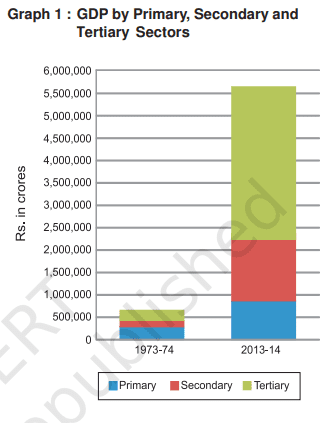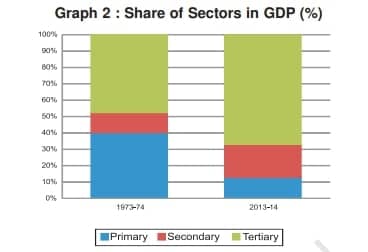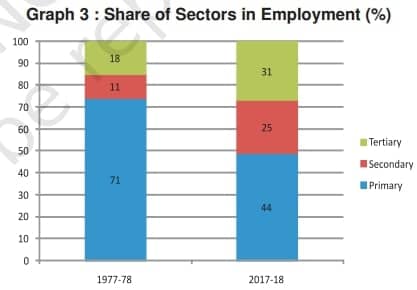NCERT Economics Class 10 | Primary, Secondary and Tertiary Sectors in India Notes
Topic & sub-topics covered: Primary, Secondary and Tertiary Sectors in India, Rising Importance of the Tertiary Sector in Production, Where are most of the People Employed?, How to Create More Employment?: Sectors of The Indian Economy (All single detail notes are exam-oriented).
We have discussed in-depth and exam-oriented pointers that can be asked in the board exam of class 10th about “Primary, Secondary and Tertiary Sectors in India, Rising Importance of the Tertiary Sector in Production, Where are most of the People Employed?, How to Create More Employment?” which is taken from the NCERT Economics notes for class 10th chapter no. 2 “Sectors of The Indian Economy“.
Download NCERT Economics Chapter 2 Class 10th Notes PDF for “Sectors of The Indian Economy”
NCERT Economics Class 10th Chapter 2 Sectors of Indian Economy Class 10 pdf
Embark on a journey to understand the intricate dynamics of economic development with NCERT Economics notes Chapter 2 Class 10th Notes. Delving into the essence of “Sectors of The Indian Economy,” these notes offer a comprehensive overview of key concepts, theories, and real-world examples.
Available in PDF format, these notes provide a convenient and accessible resource for Class 10th students to enhance their understanding, facilitate revision, and excel in their studies. Download NCERT Economics Notes Chapter 2 Class 10th Notes PDF now and unlock the keys to comprehending context.
Primary, Secondary and Tertiary Sectors in India

1. Graph Analysis:
- Graph 1 illustrates the production of goods and services across three sectors.
- Data is presented for the years 1973-74 and 2013-14, enabling a comparison over a forty-year period.
2. Historical Perspective:
- Comparing production data from 1973-74 to 2013-14 provides insights into the economic development of the country.
- Students can grasp the magnitude of growth and changes in production patterns over four decades.
3. Graphical Representation:
- Graphs serve as visual aids for understanding complex data sets.
- Students can learn to interpret graphical information effectively for better comprehension of economic concepts.
Rising Importance of the Tertiary Sector in Production
1. Sectoral Growth Trends:
- Over the forty-year period from 1973-74 to 2013-14, production increased in all three sectors.
- The tertiary sector experienced the highest growth rate, surpassing the primary sector to become the largest-producing sector in India by 2013-14.
2. Reasons for the Tertiary Sector’s Importance:
A. Various factors contribute to the increasing significance of the tertiary sector in India, including:
- Provision of essential services such as healthcare, education, transportation, and administration, which are the responsibility of the government in developing countries.
- Development in agriculture and industry stimulates demand for supporting services like transport, trade, and storage.
- Rising income levels lead to increased demand for services like dining out, tourism, shopping, and private healthcare and education, especially in urban areas.
- Emergence of new services based on information and communication technology (ICT), which have experienced rapid growth in recent years.
3. Disparities Within the Service Sector:
A. Despite overall growth, disparities exist within the service sector:
- Highly skilled and educated workers are employed in certain specialized services, while a large number of workers are engaged in low-paying jobs like small shopkeeping and repair services.
- Many workers in the service sector struggle to earn a living due to the lack of alternative employment opportunities.
4. Implications for Future Study:
- Students will explore further details about the dynamics and challenges within the service sector in the upcoming section.
- Examples of new services based on ICT and their expansion reasons will be discussed in Chapter 4 for better understanding.
Where are most of the People Employed?


1. Graphical Representation of Sectoral Contribution:
- Graph 2 illustrates the percentage share of the primary, secondary, and tertiary sectors in GDP over forty years.
- It provides a visual depiction of the changing importance of these sectors in the economy.
2. Discrepancy Between Sectoral Contribution and Employment:
- Graph 3 displays the share of employment in the primary, secondary, and tertiary sectors in 1977-78 and 2017-18.
- Despite changes in GDP sectoral shares, the primary sector remains the largest employer in India.
3. Reasons for Lack of Shift in Employment:
- Insufficient job creation in the secondary and tertiary sectors prevented a similar shift in employment.
- While industrial output increased significantly, employment in the industry only rose moderately.
- Likewise, though production in the service sector surged, employment growth was comparatively slower.
4. Underemployment in Agriculture:
- Despite a large workforce, the agricultural sector contributes only a fraction to the GDP.
- Many workers in agriculture are underemployed, meaning there are more workers than necessary for the level of production.
- This underemployment is exemplified by workers like Laxmi’s family, where each member contributes but none are fully employed.
5. Concept of Disguised Unemployment:
- Disguised unemployment refers to underemployment that is not overtly visible, as individuals appear to be working but are not fully utilized.
- Laxmi’s family scenario illustrates disguised unemployment, where all members work but their labor is not fully utilized.
6. Mitigating Underemployment Effects:
- Transitioning surplus agricultural workers to other sectors can increase overall family income without affecting agricultural production.
- Examples like Laxmi’s family moving some members to other work demonstrate how underemployment can be addressed.
7. Extent of Underemployment Across Sectors:
- Underemployment is not confined to agriculture; it also exists in urban service sectors.
- Many casual workers struggle to find daily employment, resulting in underutilization of skills and limited income opportunities.
8. Impact of Underemployment on Income:
- Addressing underemployment can lead to increased family income, benefiting both individuals and the overall economy.
- Opportunities for better employment can uplift workers from underemployment situations, improving their livelihoods.
How to Create More Employment?

1. Addressing Underemployment in Agriculture:
- Underemployment in agriculture can be alleviated by improving irrigation facilities, such as constructing wells or dams, to enable multiple cropping seasons.
- Investments in irrigation infrastructure can create employment within the agricultural sector, thus reducing underemployment issues.
2. Enhancing Agricultural Productivity and Market Access:
- Improved transportation infrastructure, including rural roads and storage facilities, facilitates the transportation and sale of agricultural products.
- Government investments in transportation and storage infrastructure can create employment opportunities in both agriculture and related services.
3. Access to Affordable Agricultural Credit:
- Access to affordable credit enables farmers to purchase seeds, fertilizers, and equipment necessary for cultivation.
- Providing cheap agricultural credit through local banks helps alleviate financial constraints faced by small-scale farmers like Laxmi.
4. Promotion of Rural Industries:
- Identifying and promoting industries and services in semi-rural areas can generate employment opportunities.
- Examples include setting up dal mills, cold storage facilities, and honey collection centers, which can create jobs in processing and marketing agricultural products.
5. Expansion of Educational and Health Sectors:
- Increasing investment in education and healthcare sectors creates employment opportunities for teachers, healthcare professionals, and support staff.
- Expansion of educational institutions and healthcare facilities, particularly in rural areas, can address both employment and development needs.
6. Harnessing Regional Potential:
- Every state or region has a unique potential for income and employment generation, such as tourism, regional crafts, or IT services.
- Proper planning and government support are essential to leverage regional potential for job creation and economic growth.
7. Short-Term Measures:
- Short-term employment generation measures like the Mahatma Gandhi National Rural Employment Guarantee Act 2005 (MGNREGA) provide 100 days of guaranteed employment to rural workers.
- MGNREGA prioritizes works that enhance land productivity, ensuring sustainable employment while boosting agricultural output.
8. Role of Government Intervention:
- Government intervention through policies and programs plays a crucial role in creating employment opportunities and promoting economic development.
- Initiatives like MGNREGA demonstrate the government’s commitment to addressing unemployment and underemployment issues at the grassroots level.
Next & Previous Topics of NCERT/CBSE Economics Class 10 Chapter 2: Sectors of The Indian Economy
FAQ
Q1. Why is the primary sector crucial?
Answer: Without raw materials from this sector, there’d be nothing to manufacture or trade!
Q2. How does the secondary sector impact the economy?
Answer: By adding value to raw materials and creating employment opportunities, it fuels economic growth and development!
Q3. How do the tertiary sectors in India contribute to GDP?
Answer: Despite not directly producing goods, the services provided by this sector are essential for economic growth and well-being.

